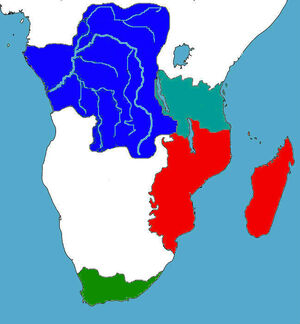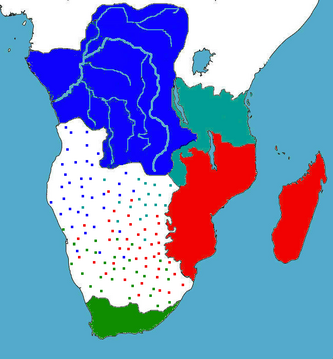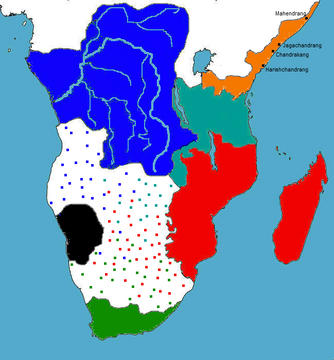| 888-1082 (135-329 AD) (L'Uniona Homanus) | 1082-1155 (329-402 AD) (L'Uniona Homanus) | 1155-1310 (402-557 AD) (L'Uniona Homanus) |
Post War Africa[]
Due to the settling down of the African states, with the powers in that area rather well-established, there was an attraction to that continent from other exiled people of the nearby area. In India the Buddhists were once again being exiled from the Maurya Empire, a task which seemed to become necessary not too often after the last purge. This group of Buddhists was sponsored by a wealthy merchant man who happened to hold the same faith. He led many of the Buddhists to come with him to Africa, a place which he had heard much about being a tradesman on the West coast of India. Before the government could seize more of his assets because of his religion he decided to up and leave one the environment became clearly too hostile. He brought many of the local Buddhists he knew with him and they intended to sail to the Bantu Kingdom. Some other groups left to live in the Kingdoms of the Thai, Khmer, Lao-Cham, Tibet, Java and other araes East of India.
This intrepid, young man’s name was Jahangir and he moved more of the Buddhists in the Maurya Empire, with ships he paid for, than any other of the migration routes which were followed after the Purge of 1084 (331 AD). The Bantu received the Buddhists quite with more than due hostility. They were given no land and no quarter and they were considered to be so much akin to the Satavahana that many believed that they were spies with a clever plot to take down their Empire. This infamous rumor spread as fast as the Buddhists had to and the violence which was shown towards them led to the commandeering of many of their ships and the deaths of many of their people in the Bantu Kingdom. The Bantu people’s hostility was returned again in the Zulu Republic but to a much less severe degree.
When the Buddhists, who were down to half their original size, came upon the Satavahana Kingdom they were greeted at first because the Satavahana believed them to have information about the Maurya Empire and its possible weaknesses. As over the course of the three years that the Buddhists stayed in the Satavahana Empire, it became increasingly obvious that they were lying. eventually they were placed in a slum town on the southern border of the country but they were eventually expelled entirely from the Kingdom in the year 1089 (332 AD). The Buddhists followed the coasts looking for an area that would be far away from the areas of the Satavahana or any other Kingdom. While they resided in the Satavahana Kingdom they managed to convert some new people and they followed them on their journey into the heart of southern Africa.
Journey to the Golden City[]
Jahangir was still leading these people though they were becoming restless and upset with their current situation. They were tired of exile and exodus into unfamiliar lands, and had decided to follow the fertile coasts until they could set up a reasonable civilization center. They eventually settled the land they named Sidharthang (Bhisho). The city was named after Siddhartha Gautama, the name of the original Buddha. It grew at a fine pace in the early days but the tribes in that area began to wonder about this development. The first of these indigenous people to raise their concerns were the Xhosa people. Rather than attacking this new city the Xhosa chose to integrate with them. Some of them even became Buddhists themselves. The animist religion of the Xhosa was very compatible with the Buddhists. As their religions merged together they became a new form of Buddhism named Siddharthism.
The Siddharthists and the Xhosa continued to grow and began to gain some of the lands of the Xhosa tribe. The city of Sidharthag was became the largest in Southern Africa and was named Golden because of its unique position that allowed its people a peaceful life. This name would gain a new meaning later in the life of this city. Sidharthang was led still by Jahangir and he began to survey the lands which surrounded his city. In one of the rivers that irrigated the hinterlands, Jahangir found gold in the water. He kept this a secret and began to research the gold mining techniques which had been gathered from other people. In the Roman Empire in Northern Africa there were many gold mines in what was Nigeria. These methods of searching for and mining for these resources was bought by Jahangir and he began to build up a group of people that would work on such missions. The iron necessary for the mining projects was also found and gained by Jahangir who was increasingly referred to as ‘King’. However it wouldn’t be long until many of the people of the city and the tribes of that area began to look for the employment and better lives inside of the city.
Jahangir and his people needed to keep this a secret from people like the Satavahana so that they wouldn’t
The area of the Sidharthists after the defeat of the Tswana
The Emergence of the Siddharthist Republic[]
Siddharthang began a run away cycle of expansion after the gold started to bring in the money and trade to min more gold and then make more money until there were several different industries and markets flourishing in the city. The wealth this brought to the government in taxation also made the Siddharthists something of a power on the African continent. Several dispersed tribes around them were either immigrating into the cities under the Siddharthang hegemony on their own or were encouraged by citizens of those cities. Rarely did the Siddharthists have to engage in actual warfare with these people, not as if their military wasn’t powerful enough to handle it when such necessity did arise. By the year 1122 (369 AD) Siddharthang was the largest city in Southern Africa and their trade connections and military were so established that the other powers would not attempt to attack them.
The Siddharthists remained humble however. They did not refuse trade with nations like the Maurya Empire and the Satavahana Kingdom, two nations which cast out the people that would found this trade giant. 1123 (370 AD) was the year that Jahangir, who had been incapacitated for some time but still alive, died of old age. He was the first and last King of Siddharthang and in the latter years of his reign prominent representatives of the districts in the city were building up their power to succeed him. Jahangir had many children but many of them were not interested in political life. Some were generals and others patrons of merchants and other wealthy endeavours even joined the Council of the city for some time. The Council of Siddharthang took over the government peacefully and with the approval of Jahangir on his death bed. The Siddharthist Republic, trade capital of Africa was now firm and grounded in the political stage.
The Legend of Magaditra[]
Among the tribes of Southern Africa existed a legend of a city known as Magaditra. It was renowned i that region as a great Empire all around the Southern portion of Africa and to have pre-dated even Aegyptus and Persia. It is said to have controlled a vast amount of gold and silver, so much that it flowed like water. Its people and its society were said to be so prosperous that the gods punished their excesses and pride. This resulted in the creation of the Kalahari desert and many of the tribes native to these lands believed that this area was devoid of all resources as part of this divine punishment. Because of this the Southern portion of Africa was discounted as a place of interest by many of the African coutnries or tribes.
However, the Siddharthists were discovering something very different. Their lands on the bottom of the continent were seeming to be some of the most wealthy in the world. From diamonds to gold and silver there were veins of almost any of the riches of the world in the Siddharthist Republic. This prompted many of the Zulu Chiefdoms and the Satavahana to explore and look for minerals in the desert. The surveyors and explorers who went on these missions were under the commission of the Kings and Chiefs and leaders of their countries and almost all of them exaggerated the degree to which this area bore resources. By the end of the year 1130 (377 AD) the Satavahana, the Siddharthists, and the Zulu believed that there were more resources in this area than anywhere else in the known world.
The Two Decades of Settlement[]
After 1130 (377 AD) the governments of these African Empires began spending considerable amounts of money on the settlement of this area. The Bantu entered around a quarter way through this process and had fewer cities
The Distribution of Settlements made during the years 1130-1151 (377-398 AD)
“The ground is so ripe for the process of mining and it has such a surplus of minerals and all sorts of precious stones and metals that it would be against Your Majesty’s interest not to extend your kingdom to these wealthy and glittering lands.” -from a Letter by a surveyor to King Lankesh IV of Satavahana.
The Bantu settled lands between all three nations and eventually settled on a treaty what would attack the main portion of their nation with their small colony so as to prevent possible conflicts. this strip of land was given by the Zulu Kingdom and allowed the Bantu and the Zulu to work together to settle the lands immediately to their south. The Siddharthists moved into the lands to the North and the Satavahana settled the West but they did not settle contiguously. Many times there were cities surrounded by other cities from another nation. The cities were small however and for the time being the space between them allowed for travel through this area without much problem. Much of this resulted from the inaccurate maps of the area which were made and which ended up making some go extremely far in search of an area that was not meant to be more than a day’s distance. This confusion increased with the advent of a new part of society, Bandits.
The Bandit Settlement and the Indian Intervention[]
Many of the people who moved out into these areas for the purpose of profiting from the resources believed to be there, left because they disliked their lives back in the main parts of their country of origin. They established new
An estimation of the area controlled by the Bandit Nation.

Area given to the Maurya by an agreement of African Powers.
In the area north of the Bantu Kingdom, the Maurya Empire set up its first potential settlement in the year 1138 (385 AD). This area was also south of the Roman Province of Ethiopia and the Maurya constructed an exclusive contract with the Ethiopian Governor and the Bantu King. The wealth and the prestige that the Maurya possessed impressed greatly upon the King of the Bantu and the Romans had good relations with the Maurya for some time, though they recently lose them as a trade partner. It should be noted that in the Roman Empire there was so much trading going on and there was such a massive population in the Empire that the markets only vibrated slightly rather than falling entirely. The lack of great impact of the Maurya’s choice allowed both nations to remain on good terms. Despite this, the Maurya agreed to allow trade between Africa and Rome through the territory that the Romans and the Bantu agreed not to lay any claim to.
Also as part of this treaty was a strict condition to keep the existence of this area as secret as possible. There were around four main port cities from which armies, navies, and other necessary military establishments would be built in the twelve years from 1138-1150 (385-397 AD). These four ports, Mahandrang, Jagachandrang, Chandrakang, and Harishchandrang were all established in order to take the Satavahana by surprise and assure that there was a base from which they could maneuver without out having to traverse the great distance that there was from the Satavahana Kingdom to the Indian sub-continent. By the end of the year 1155 (402 AD) there was already a network to support a war effort. The African continent would erupt after this time.
[]
| 888-1082 (135-329 AD) (L'Uniona Homanus) | 1082-1155 (329-402 AD) (L'Uniona Homanus) | 1155-1310 (402-557 AD) (L'Uniona Homanus) |
